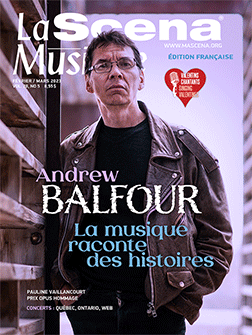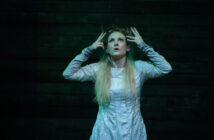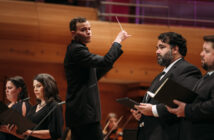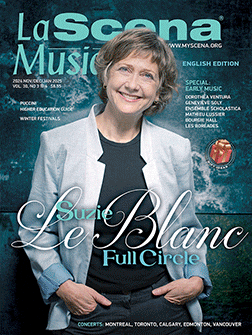
This page is also available in / Cette page est également disponible en:
![]() Francais (French)
Francais (French)
From a historical perspective, Jules Massenet’s art songs have been given short shrift compared with his larger-scale operatic undertakings like Manon, Werther and Cendrillon. Baritone Pierre Bernac (1899-1979), in a work dealing with the interpretation of French art songs, is unequivocal in his assessment of Massenet; he viewed him as being a gifted melodist who wrote tunes wrapped in sugar-coated sentimentalism.
If only a few pieces survive now as tokens of that repertoire, it may be due in part to the composer’s reluctance to deal with the subject. Jacques Hétu, in his liner notes to the recently issued box set of the composer’s vocal works (see sidebar), reveals that “in his biography, Mes Souvenirs, Massenet pays little attention to the mélodies, which form, by their number and variety, a significant part of his output. There is no mention of them, with few exceptions.”
One of the reasons for this neglect might have to do with the lyrics themselves—more pointedly, the literary sources he drew on. The sonnets of one Gustave Chouquet (1819-1886) are striking in the awkwardness of certain rhymes, yet Massenet seemed undeterred by them and turned three of them into a cycle he titled Chants intimes, written in 1866. Conversely, he composed eight songs for the cycle Poème d’avril that same year on poems by Armand Silvestre (1837-1901), an author blessed with a much more sophisticated turn of phrase, some quite moving.
Throughout his active career until his death in 1912 at age 70, Massenet also found inspiration in works penned by some 30 women poets, a sure indication of gender equality on his part, and far ahead of his time for that matter. He wrote the songs Lui et elle, Beaux yeux que j’aime, Les belles de nuit, Idéal and Aux étoiles based on the verses of Thérèse Maquet (1858-1891). What’s more, he composed the bulk of his last cycle of songs—Expressions lyriques—in the year of his death by putting into music the poems of Seymourina Poirson (1846-1931), Countess Cécile Roch de Louvencourt, Madeleine Grain and Jeanne Dortzal (1878-1943), the latter for three songs. And Massenet actually undertook this cycle at the behest of a singer, French mezzo-soprano Lucy Arbell (1878-1947).
Musicologist Damien Top stresses the innovative approach of Massenet’s writing for a voice that actually harkens to the declamatory style that Debussy would use shortly after the turn of the century in Pelléas et Mélisande. Massenet’s marked preference for lower voices in the middle register enables him, in Top’s view, to focus on diction and a clear understanding of the poetic substance, rather than on vocal virtuosity. Top makes the point that the depth of interpretation always prevailed over virtuosity, a fact that Massenet never wavered on in the half-century of work he did to achieve a unique stature in the annals of French music, which was to allow the singing voice to gradually rise out within the prosody.
Betwixt Romanticism and Impressionism
Italian researcher Raffaele D’Eredità offers insight on this topic using words from a renowned musicographer of the time, Jean d’Udine (1870-1938): “Massenet’s mélodies are formed through a perfect fusion of the search for an elegant and voluptuous phrase, which translates as charm, a profound knowledge of the potential of the sung voice, and rigorous attention to prosodic emphasis, capable of elevating the French language.”
If Massenet was attached to composing music mindful of French speech inflections, this concern was related to his fascination with the theatre and the abilities of actors to project their voices, both men and women—two of whom were Jean Mounet-Sully (1841-1916) and Sarah Bernhardt (1844-1923). In his memoirs, the composer acknowledges this upon attending a performance of Alexandre Parodi’s tragedy Rome vaincue in 1876. The two lead actors, in his view, were the most moving protagonists in both acts. The annotator of the box set, Jacques Hétu, rightly points out that observation, which also holds for Debussy, equally impressed by actors.
But these views are not the only affinities shared by these two men. Gérard Condé, in his study entitled Le piano, révélateur de l’orchestre chez Massenet and quoted in the liner notes, deems that Massenet’s music “was approached from the perspective of acoustics and imagined in terms of a music of sound rather than a music of notes, and it is all the more remarkable when it creates an atmosphere, when it gains one’s ear, and as such Massenet’s Méditation from Thaïs is particularly close to the exactly contemporary Prélude à l’après-midi d’un faune.”
Within the entire body of mélodies, some stand out for their ability to conjure a special moment or an impression that transcends the notations. One of these instances, Sonnet matinal, appears to perfectly capture a morning sunrise through music. There is so much attention given to the sonorities, the reflections of light and special pianistic effects all so imbued in impressionism, but never to the extent of breaking through the barriers of tonality that Debussy vied for. Seen that way, Massenet remains a man of the 19th century.
Early works—like La fleur et le papillon (1862) and Poème pastoral (1872)—show a marked interest in subject matter of a bucolic nature, where nature and human emotions intertwine. Although their moods are somewhat more upbeat and carefree than those of a Schubert or Schumann lied, these songs are not immune from sudden twists of ill-fate.
In his notes, Hétu first encapsulates German romanticism before contrasting it to the French concept: “Nature, today in irretrievable decline, is not a mere setting or an image frozen in time. It accompanies the poet in his quest on a moonlit, transfigured night. Nature becomes sighs and regrets, the echo of restless sorrows. It is like a synchronous mirror of the senses. …These songs, unlike the elitist French mélodie, were rooted in popular culture. Some of Massenet’s mélodies do have a popular character—his cycles are steeped in the picturesque landscapes of the seasons, in contemplative atmospheres that depict the scenes—and do not fall within the same category as Fauré’s aristocratic mélodies.”
The culture of the literary salon, deeply rooted in the French 18th-century aristocracy, definitely rubbed off on the music in a profound way, more specifically in the subtle uses of language and great attention invested in the prosody, all of which make Massenet’s artistic output quintessentially French. Yet, there lurks a Germanic element in his scores. As Schubert did by setting Goethe’s words of the Erlkönig to one of his most famous lieder, the author of Manon has an equal fondness for dramatic storytelling. Such is the case of the magnificent dirge ending the Poème d’avril cycle.
Patrick Fournillier, a past director of the biennial Massenet Festival (1990-2012), offers a few insights on this last piece: “Massenet adhered not only to the storyline in the creative process, but to each word, and it’s apparent that every change in orchestral colour, harmony and dynamics is informed by the very word.” Hétu, for his part, notes in the forward to his extensive essay that “the maestro’s notes soutenu et expressif (sustained and expressive) for the piano and assez lent et avec exaltation toujours croissante (slowly and with increasing intensity) for the voice, which often appear in the stage direction, reflect the dramatic character of his highly expressive music.”
Massenet churned out 25 operas in his lifetime, proof positive of his fondness for vocal music embedded in musical drama. His songs, for their part, are like vignettes drawn out of a larger compendium—bite-size imaginary operas where harrowed lovers meet, animals suddenly talk or nature’s inanimate objects suddenly come to life. Debussy himself succumbed to the temptation, according to Hétu, and its voluptuous excitement that characterized the music makes one want to love it in an act of forbidden love. Also quoted is Henri Duparc’s quip, worth mentioning here: “Debussy strives too hard to please; he is too attached to the caress of sounds; his music delights me, but I seek something else. This refined sensuousness can already be found in part in Mr. Massenet’s music.”
Coinciding with the issuing of this box set anthology of Jules Massenet’s vocal works, ATMA Classique staged a public event last December at the Chapelle historique du Bon Pasteur. After having issued similar sets of works by Poulenc in 2013 and another on Fauré five years later, Massenet was the third in the series from this local imprint spearheaded by Johanne Goyette. Marc Boucher took on the duties once again as artistic director of this project while lending his voice to the proceedings, with the support of Olivier Godin, the one-man orchestra at the keyboard. All told, there are 13 discs in this anthology that is dually significant: as the first complete set of Massenet vocal works ever, and secondly as an unparalleled initiative of musical documentation in Canada.
The cast
The first recordings for this project of almost overwhelming proportions occurred in the autumn of 2020. As strange as it may seem, the raging pandemic worked in favour of the artists involved because everyone was close to home and available for recording rather than being saddled by travelling schedules, as many of them are. No less than 17 singers participated in this compendium of 333 songs, including more than a handful of our finest: sopranos Karina Gauvin, Sophie Naubert, Anna-Sophie Neher and Magali Simard-Galdès; mezzos Julie Boulianne and Michèle Losier; contraltos Florence Bourget and Marie-Nicole Lemieux; tenors Frédéric Antoun, Antoine Bélanger, Antonio Figueroa, Emmanuel Hasler, Joé Lampron-Dandonneau and Éric Laporte, and baritones Marc Boucher, Jean-François Lapointe and Hugo Laporte.
The vast majority of this musical treasure trove was conceived for voice and piano accompaniment—but not just any instrument in this case. Hétu says “the acquisition of an 1854 Érard concert grand piano, a rich and subtle instrument tuned to the pitch of 435 Hz (standardized by a law passed in Paris in 1859) made it possible to reproduce, with the greatest accuracy, the harmonics of Massenet’s time.”
Only a few pieces include other instruments, these being violin, guitar, harp, cello, harpsichord and harmonium. Antoine Bareil, David Jacques, Valérie Milot and Stéphane Tétreault fill in those chairs. Added to that are some spoken-word segments provided by Marie-Ève Pelletier, Jean Marchand and Jean-François Lapointe, the latter heard in the first discs covering the earlier works. The set also contains some non-standard items, like Poème pastoral during which four voices (three female and one male, accompanied by piano) are heard as well as in the sixth and final number, subtitled Adieux à la prairie.
By reprising the pieces as they were conceived, this box set respects the composer’s intentions, and resurrects a significant portion of his musical output that had, until now, languished in obscurity.
Translation by Marc Chénard
Bibliography
Raffaele, EREDITÀ, D’, “Le compositeur “enrichi”: La réception controversée de l’oeuvre de Massenet au prisme de sa condition sociale” [en ligne], in: Revue Proteus : Financement et valeurs de l’art, no 13/janvier 2018, pp. 56-69. https://docplayer.fr/109159582-Le-compositeur-enrichi-la-reception-controversee-de-l-oeuvre-de-massenet.html (consulté le 27 janvier 2023)
Jacques HÉTU, livret discographique, in: Jules Massenet: intégrale des mélodies pour voix et piano [en ligne], Analekta, Montréal, 2022. https://atmaclassique.com/storage/2022/11/722056441728_e_Booklet_Massenet_Fi_2.pdf (consulté le 27 janvier 2023)
Damin TOP, “Le testament lyrique de l’expression mélodique” [en ligne], in: Tempus perfectum, no 9/été 2012, Symétrie, Lyon, p. 3. https://images.symetrie.com/e/p/isbn_978-2-36485-008-8.pdf (consulté le 27 janvier 2023)
This page is also available in / Cette page est également disponible en:
![]() Francais (French)
Francais (French)












